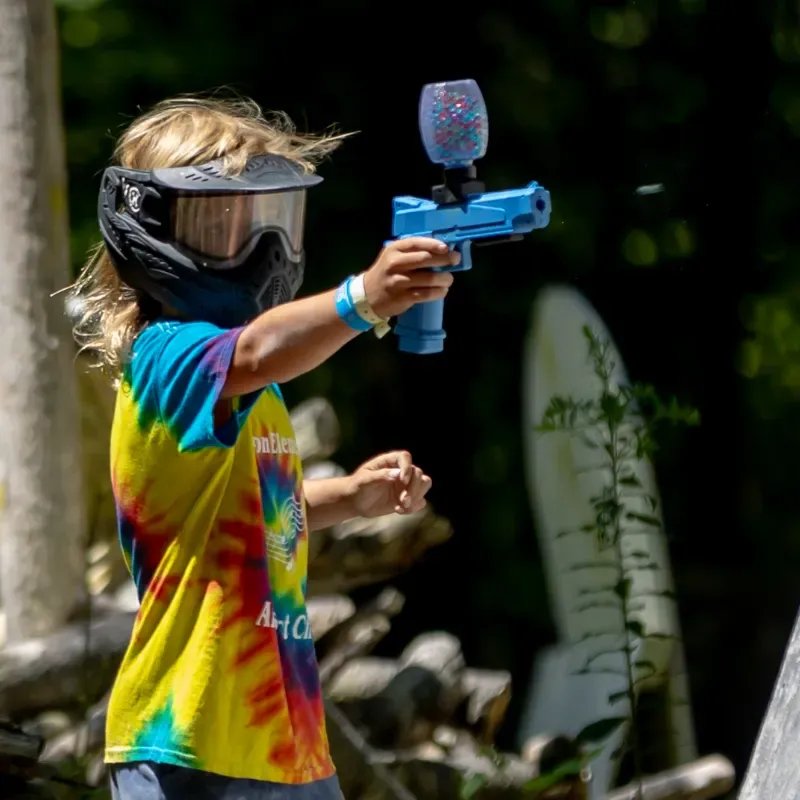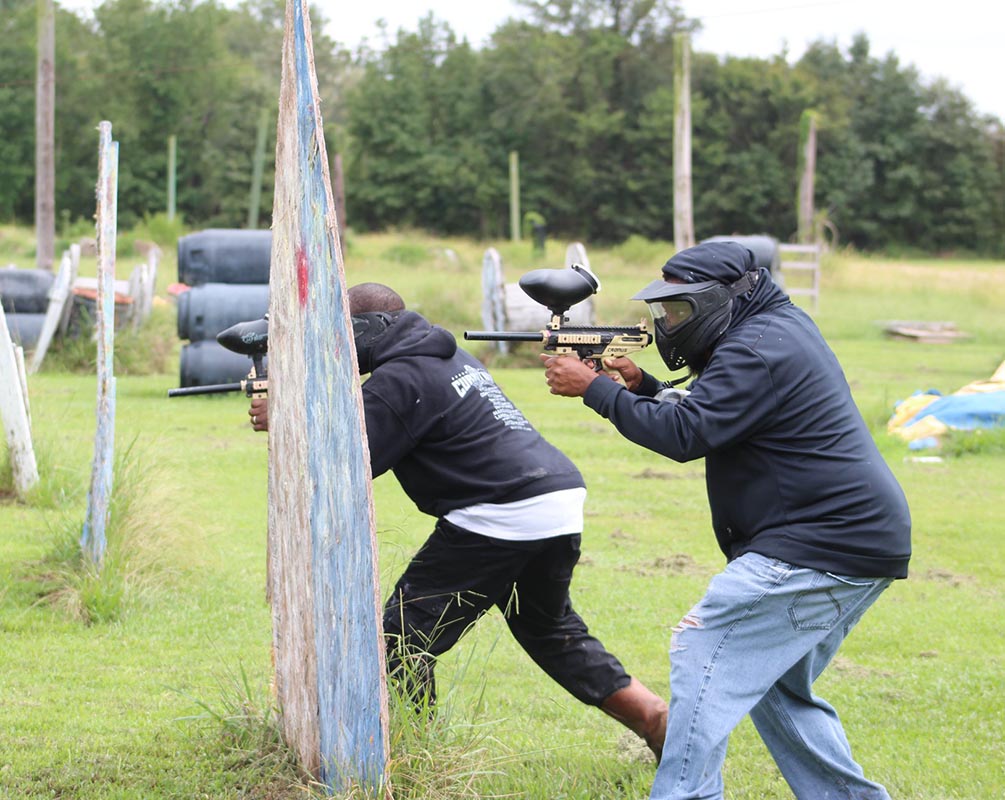Gel Blaster vs. Paintball: Which Hurts More2024-04-09
Recreational shooting sports like gel blasters and paintball have soared in popularity, offering adrenaline-packed thrills by firing projectiles at opponents. But a key question arises: which activity inflicts more pain upon impact? This guide compares gel blasters and paintballs, examining factors like projectile properties, safety gear, distance, and gameplay to assess potential pain levels. By understanding these elements, you can make an informed choice based on your personal pain tolerance and preferences.
Understanding Gel Blasters
Gel blasters, also known as gel ball blasters or hydro blasters, are recreational shooting devices that fire water-based gel projectiles. These compact and lightweight blasters come in various forms, ranging from pistols to rifles, catering to different play styles and preferences.
The Nature of Gel Balls
Gel balls are typically composed of a water-based polymer material, often with a colorant added for enhanced visibility. These projectiles have a soft, squishy texture designed to absorb impact upon contact, minimizing the risk of injury. Gel ball sizes can vary, with diameters ranging from 6mm to 8mm and weights between 0.12 and 0.20 grams.
While the impact of gel balls can cause temporary stinging or mild discomfort, they are generally considered less painful compared to their paintball counterparts. This is due to their soft, pliable nature and lower kinetic energy upon impact.
One key advantage of gel balls is their reduced risk of causing serious injury, making them a safer option for recreational play, especially for younger participants or those with a lower pain tolerance.

Understanding Paintball
Paintball is a well-established sport with a long history and a dedicated following, complete with organized competitions. Paintball guns, also known as markers, are designed to fire paintball shells filled with a water-soluble, non-toxic paint mixture.
Composition of Paintballs
Paintballs typically range from 0.68 to 0.50 caliber, with a diameter of around 17.8mm and a weight of approximately 3 grams. These projectiles feature a thin, brittle outer shell that breaks upon impact, releasing the paint inside.
The hardness of the paintball shell and the velocity at which it is fired are crucial factors that can significantly contribute to the level of pain experienced upon impact. Harder shells and higher velocities can result in more intense impacts and a greater potential for bruising or discomfort.
It's important to note that while paintballs are designed to break upon impact, reducing the risk of serious injury, the force of the impact can still be substantial, especially at closer ranges or when hitting sensitive areas of the body. Proper protective gear is essential when engaging in paintball activities to mitigate the risk of injury and ensure a safe and enjoyable experience.
Measuring the Pain-Impact Analysis
While assessing pain is inherently subjective as it can vary from person to person, analyzing factors like kinetic energy and impact force provides a more objective understanding of the potential for discomfort and injury in gel blaster and paintball games.
Kinetic Energy and Impact Force
Kinetic energy is the energy an object has due to its motion. The higher the kinetic energy, the greater the force of impact upon collision. Generally, paintballs have higher kinetic energy compared to gel balls because paintballs are heavier and fired at higher velocities.
This increased kinetic energy translates to more forceful impacts upon contact, resulting in a higher potential for bruising or even injury in paintball compared to gel-blaster games. The force of impact from a paintball can be substantial, especially at closer ranges or when hitting sensitive body areas.
Anecdotal Experiences
While scientific data is valuable, it's also important to consider the real-life experiences of players in both sports. Many gel blaster enthusiasts report a stinging sensation upon impact, often likened to being snapped by a rubber band. However, paintball players frequently describe more intense, bruising impacts, particularly at close quarters or when hit in vulnerable areas like the neck or groin.
These firsthand accounts highlight the potential for greater discomfort and higher risk of injury in paintball compared to gel blaster games, corroborating the scientific analysis of kinetic energy and impact force.
It's worth noting that individual pain tolerance also plays a role in how these impacts are perceived, with some players being more sensitive to pain than others. Nonetheless, the consensus among players suggests that paintballs generally inflict more intense and potentially painful impacts compared to gel balls.
Safety and Protective Gear
No matter if you're playing with gel blasters or paintballs, safety should always come first. Wearing the right protective gear can help reduce the pain you feel if you get hit and lower your chances of getting hurt.
What to Wear for Protection
When playing with gel blasters, it's a good idea to wear eye protection like goggles or a face mask. You should also wear long-sleeved shirts and pants to cover your skin. For extra protection, you can wear lightweight body armor or clothing with padding.
Paintball needs even more protective gear. You'll want a full-face mask that covers your entire face. Wear clothing with padding, like a special paintball jersey, to cushion any hits. For more intense games, you might also want to protect your neck and groin area.

Importance of Following Safety Rules
Both gel blaster and paintball games usually have specific safety rules that everyone has to follow. These rules might include:
● Staying a certain distance away from other players when shooting
● Having special safe areas where you can't shoot
● Wearing the right protective gear and clothing
It's super important to always follow these rules. They help make sure that everyone has a good time and stays safe while playing. The rules are there for a reason, so don't ignore them!
Factors That Affect Pain Levels
The type of balls used in gel blasters and paintball guns definitely make a difference in how much it hurts when you get hit. But there are other things that can change how painful it feels too.
How Far Away You Are
The distance between you and the person shooting at you can change how much it hurts. If you're really close, the balls will hit you harder because they haven't slowed down yet. But if you're farther away, the balls will be moving slower and won't hurt as much when they hit you.
What You're Wearing
The clothes you wear can also help protect you from feeling as much pain. If you have thick, padded clothes, they can cushion the balls when they hit you. This means you won't feel the impact as much and you'll be less likely to get bruises.
The Type of Game You're Playing
Different types of games can also affect how hard you get hit. For example, if you're playing a game where you have to stay far away from each other, the balls won't hit you as hard. But if you're playing a game where you have to fight close together, like pretending you're in a small battle, the balls might hurt more because you're closer to the person shooting.
So even though the type of ball matters a lot, these other factors can also change how painful it is if you get hit. It's good to think about all of these things when you're deciding what kind of game to play and what to wear.
Additional Factors in Choosing Between Gel Blasters and Paintball
Deciding whether to play gel blaster or paintball isn't just about how much it might hurt. There are other important things to consider too.
How Much It Costs
Gel-blaster games are usually cheaper to start playing than paintball. The gel balls themselves cost less than paintballs. And the guns and other gear you need for gel blaster are often not as expensive as the fancy paintball guns and accessories.
Where You Can Play
Depending on where you live, it might be easier to find places to play one game or the other. Paintball has been around longer, so lots of places have paintball fields already set up. But gel blaster is becoming more popular really fast, especially in areas where there might not be as many paintball fields.
Cleaning Up After Playing
When you're done playing Gel Blaster, cleaning up is pretty easy. You just need to wipe off your gun and make sure there's no gel left on it. But paintball guns need a bit more work to clean. You have to take them apart and clean all the little pieces inside to make sure they keep working properly.
Choosing the Right Shooting Sport for You
when deciding between gel blaster and paintball, it's important to think about how much pain you can handle and what type of experience you want to have. Paintballs usually hurt more than gel balls because they are heavier and move faster, but wearing the right protective gear can help make both games safer and less painful. Other things to consider include the cost of equipment and where you can play each game. Gel blasters are often cheaper and easier to clean up, while paintball has more established fields and communities. No matter which one you choose, always follow the safety rules and have fun!
Read more:
- Company Info
- About Us
- Contact Us
- Customer Reviews
- Blogs
- Brands
- YouTube Videos
- User Center
- FAQ
- Forget Password
- My Orders
- Tracking Order
- My Account
- Register
- Affiliate
- Company Policy
- Locations We Ship To
- Payment Methods
- Shipping Policy
- Refund Policy
- Privacy Policy
- Terms of Service
- Disclaimer
- Contact Us
ZHENDUO Electornics Technology LLC
Address: 7200 MISSOURI AVE,Denver,CO,United States,80202
Contact number: (626) 215-2450
Email address: xiewentao@zhenduo.email

